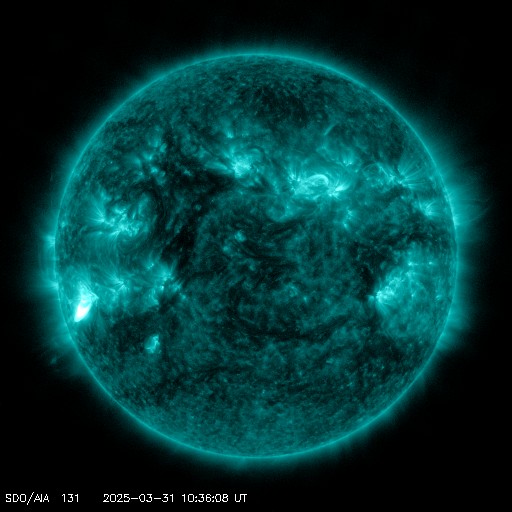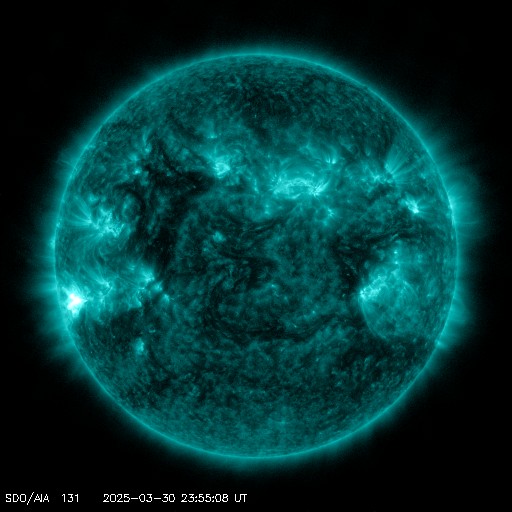Viewing archive of Thursday, 28 July 2005
Solar activity report
Any mentioned solar flare in this report has a scaling factor applied by the Space Weather Prediction Center (SWPC). Because of the SWPC scaling factor, solar flares are reported as 42% smaller than for the science quality data. The scaling factor has been removed from our archived solar flare data to reflect the true physical units.
Report of Solar-Geophysical Activity 2005 Jul 28 2204 UTCPrepared by the NOAA © SWPC and processed by SpaceWeatherLive.com
Joint USAF/NOAA Report of Solar and Geophysical Activity
SDF Number 209 Issued at 2200Z on 28 Jul 2005IA. Analysis of Solar Active Regions and Activity from 27-2100Z to 28-2100Z
Solar activity was moderate due to an M1 x-ray event at
0030 UTC from newly numbered Region 792 (N12E78). The event was
associated with a CME off the east limb with a plane of sky speed of
about 850 km/s. Region 792 is clearly the return of old Region 786,
and is likely to have been the source of the recent series of CME's
originating behind the east limb. The region was also responsible
for the remainder of today's occasional C-class and B-class
activity. Region 791 (N14W20), the only other spotted group on the
Sun, was quiet and stable.
IB. Solar Activity Forecast
Solar activity is expected to moderate
with Region 792 as the dominant source of activity. There is also a
slight chance for major flare activity from this group.
IIA. Geophysical Activity Summary 27-2100Z to 28-2100Z
The geomagnetic field was mostly unsettled to active with a minor
storm period from 0300-0600 UTC. Solar wind data indicate the onset
of a co-rotating interaction region late on the 27th followed by the
onset of coronal hole stream by about midday on the 28th. Solar wind
speed is currently steady at around 600 km/s. A greater than 10 MeV
proton event began at 2300 UTC on the 27th and reached a maximum so
far of 32 PFU at 1300 UTC on the 28th. The event continues in
progress with a flux of 27 PFU at the end of the analysis interval.
The main source for this event appears the shock driven by the fast
CME of 27/0454 UTC. It should be noted, however, the flux levels
were already enhanced prior to this event. This initial enhancement
may have been caused by one or more of the earlier CME's that
originated behind the east limb; for example the CME's of 26/0930
UTC, 25/1106 UTC, and 24/1418 UTC.
IIB. Geophysical Activity Forecast
The geomagnetic field is
expected to be mostly unsettled with a chance for some active
periods for 29 July. Conditions are expected to decline to
predominantly unsettled for 30 July and should be quiet to unsettled
for 31 July. The greater than 10 MeV proton event is expected to end
sometime on 29 July, provided that no new particles are accelerated
by new activity from Region 792.
III. Event Probabilities 29 Jul to 31 Jul
| Class M | 70% | 70% | 70% |
| Class X | 10% | 10% | 10% |
| Proton | 90% | 10% | 10% |
| PCAF | Yellow | ||
IV. Penticton 10.7 cm Flux
Observed 28 Jul 096 Predicted 29 Jul-31 Jul 105/110/115 90 Day Mean 28 Jul 096
V. Geomagnetic A Indices
Observed Afr/Ap 27 Jul 015/017 Estimated Afr/Ap 28 Jul 016/030 Predicted Afr/Ap 29 Jul-31 Jul 010/015-010/012-007/010
VI. Geomagnetic Activity Probabilities 29 Jul to 31 Jul
| A. Middle Latitudes | |||
|---|---|---|---|
| Active | 35% | 30% | 25% |
| Minor storm | 20% | 20% | 15% |
| Major-severe storm | 05% | 05% | 05% |
| B. High Latitudes | |||
|---|---|---|---|
| Active | 30% | 30% | 25% |
| Minor storm | 25% | 25% | 15% |
| Major-severe storm | 10% | 10% | 05% |
All times in UTC
Current data suggests there is a slight possibility for aurora to appear at the following high latitude regions in the near future
Whitehorse, YTAnchorage, AK, Fairbanks, AK, Juneau, AK, Utqiagvik, AK
Latest news
Latest forum messages
Unspecified geomagnetic activity 2147AR4048 38AR4046 136Solar Demon 3Aurora photography hints for those of us with smartphones 54
More topicsSupport SpaceWeatherLive.com!
A lot of people come to SpaceWeatherLive to follow the Sun's activity or if there is aurora to be seen, but with more traffic comes higher server costs. Consider a donation if you enjoy SpaceWeatherLive so we can keep the website online!

Latest alerts
11:15 UTC - Solar protons
Minor S1 Solar Radiation Storm - Minor impacts on HF radio through polar regions
10:45 UTC - Solar flare
Moderate M1.26 flare
10:27 UTC - Radio Blackout
Minor R1 radio blackout in progress (≥M1 - current: M1.22)
00:09 UTC - Solar flare
Moderate M1.03 flare
Sunday, 30 March 2025
23:51 UTC - Radio Blackout
Minor R1 radio blackout in progress (≥M1 - current: M1.03)
Space weather facts
| Last X-flare | 2025/03/28 | X1.1 |
| Last M-flare | 2025/03/30 | M1.0 |
| Last geomagnetic storm | 2025/03/27 | Kp5 (G1) |
| Spotless days | |
|---|---|
| Last spotless day | 2022/06/08 |
| Monthly mean Sunspot Number | |
|---|---|
| February 2025 | 154.6 +17.6 |
| March 2025 | 127 -27.6 |
| Last 30 days | 127 -25.7 |




